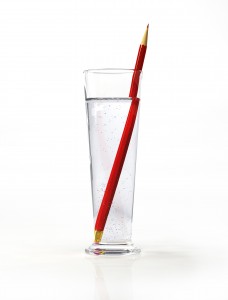
Simple Microscope & Telescope
Did you know you can create a compound microscope and a refractor telescope using the same materials? It’s all in how you use them to bend the light. These two experiments cover the fundamental basics of how two double-convex lenses can be used to make objects appear larger when right up close or farther away.
Things like lenses and mirrors can bend and bounce light to make interesting things, like compound microscopes and reflector telescopes. Telescopes magnify the appearance of some distant objects in the sky, including the moon and the planets. The number of stars that can be seen through telescopes is dramatically greater than can be seen by the unaided eye.
Materials
- A window
- Dollar bill
- Penny
- Two hand-held magnifying lenses
- Ruler
Instructions
- Place a penny on the table.
- Hold one magnifier above the penny and look through it.
- Bring the second magnifying lens above the first so now you’re looking through both. Move the second lens closer and/or further from the penny until the penny comes into sharp focus. You’ve just made a compound microscope.
- Who’s inside the building on an older penny?
- Try finding the spider/owl on the dollar bill. (Hint: It’s in a corner next to the “1”.)
- Keeping the distance between the magnifiers about the same, slowly lift up the magnifiers until you’re now looking through both to a window.
- Adjust the distance until your image comes into sharp (and upside-down) focus. You’ve just made a refractor telescope, just like Galileo used 400 years ago.
- Find eight different items to look at through your magnifiers. Make four of them up-close so you use the magnifiers as a microscope, and four of them far-away objects so you use the magnifiers like a telescope. Complete the data table.
What’s Going On?
What I like best about this activity is how easily we can break down the basic ideas of something that seems much more complex and intimidating, like a telescope or microscope, in a way that kids really understand.
When a beam of light hits a different substance (like a window pane or a lens), the speed at which the light travels changes. (Sound waves do this, too!) In some cases, this change turns into a change in the direction of the beam.
 For example, if you stick a pencil is a glass of water and look through the side of the glass, you’ll notice that the pencil appears shifted. The speed of light is slower in the water (140,000 miles per second) than in the air (186,282 miles per second). This is called optical density, and the result is bent light beams and broken pencils.
For example, if you stick a pencil is a glass of water and look through the side of the glass, you’ll notice that the pencil appears shifted. The speed of light is slower in the water (140,000 miles per second) than in the air (186,282 miles per second). This is called optical density, and the result is bent light beams and broken pencils.
You’ll notice that the pencil doesn’t always appear broken. Depending on where your eyeballs are, you can see an intact or broken pencil. When light enters a new substance (like going from air to water) perpendicular to the surface (looking straight on), refractions do not occur.
However, if you look at the glass at an angle, then depending on your sight angle, you’ll see a different amount of shift in the pencil. Where do you need to look to see the greatest shift in the two halves of the pencil?
Why does the pencil appear bent? Is it always bent? Does the temperature of the water affect how bent the pencil looks? What if you put two pencils in there?
Depending on if the light is going from a lighter to an optically denser material (or vice versa), it will bend different amounts. Glass is optically denser than water, which is denser than air.
Not only can you change the shape of objects by bending light (broken pencil or whole?), but you can also change the size. Magnifying lenses, telescopes, and microscopes use this idea to make objects appear different sizes.
Exercises
- Can light change speeds?
- Can you see ALL light with your eyes?
- Give three examples of a light source.
- What’s the difference between a microscope and a telescope?
- Why is the telescope image upside-down?